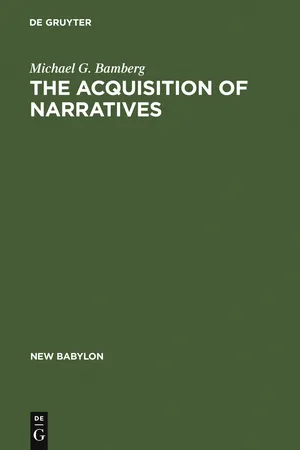
- 256 pages
- English
- PDF
- Available on iOS & Android
eBook - PDF
About this book
No detailed description available for "The Acquisition of Narratives".
Frequently asked questions
Yes, you can cancel anytime from the Subscription tab in your account settings on the Perlego website. Your subscription will stay active until the end of your current billing period. Learn how to cancel your subscription.
At the moment all of our mobile-responsive ePub books are available to download via the app. Most of our PDFs are also available to download and we're working on making the final remaining ones downloadable now. Learn more here.
Perlego offers two plans: Essential and Complete
- Essential is ideal for learners and professionals who enjoy exploring a wide range of subjects. Access the Essential Library with 800,000+ trusted titles and best-sellers across business, personal growth, and the humanities. Includes unlimited reading time and Standard Read Aloud voice.
- Complete: Perfect for advanced learners and researchers needing full, unrestricted access. Unlock 1.4M+ books across hundreds of subjects, including academic and specialized titles. The Complete Plan also includes advanced features like Premium Read Aloud and Research Assistant.
We are an online textbook subscription service, where you can get access to an entire online library for less than the price of a single book per month. With over 1 million books across 1000+ topics, we’ve got you covered! Learn more here.
Look out for the read-aloud symbol on your next book to see if you can listen to it. The read-aloud tool reads text aloud for you, highlighting the text as it is being read. You can pause it, speed it up and slow it down. Learn more here.
Yes! You can use the Perlego app on both iOS or Android devices to read anytime, anywhere — even offline. Perfect for commutes or when you’re on the go.
Please note we cannot support devices running on iOS 13 and Android 7 or earlier. Learn more about using the app.
Please note we cannot support devices running on iOS 13 and Android 7 or earlier. Learn more about using the app.
Yes, you can access The Acquisition of Narratives by Michael G. Bamberg in PDF and/or ePUB format, as well as other popular books in Languages & Linguistics & Linguistics. We have over one million books available in our catalogue for you to explore.
Information
Table of contents
- Preface
- List of Tables
- List of Figures
- Chapter One: The Establishment of Narrative Coherence
- 1 Points of departure: A consideration of relevant research trends
- 1.1 Introduction
- 1.2 Narrative structures
- 1.3 The development of narrative structures
- 1.4 Coherence and cohesive devices
- 2 The focus of the present study
- 2.1 Background
- 2.2 Picture book narration: The delineation of a discourse mode for developmental research
- 2.3 Method
- Chapter Two: Pronominal and Nominal Markers and the Establishment of Coherence
- 1 Switching and maintaining reference
- 1.1 Pronominal anaphora and discourse segmentation
- 1.2 Deixis and anaphora in the picture book narration task
- 1.3 Some structural properties of German third person pronouns
- 2 Explorations in the acquisition of anaphoric devices
- 3 Introduction to the study
- 3.1 Guiding questions
- 3.2 Coding
- 4 Results
- 4.1 Analysis and discussion of the adult narratives
- 4.2 Analysis and discussion of the children’s narratives
- 4.3 Analysis and discussion of multiple strategies in the children’s individual narratives
- 4.4 Conclusions
- Chapter Three: The Contribution of Tense to Coherence
- 1 Tense and text
- 1.1 Developmental aspects of “tenses” and “texts”
- 2 The use of tense in “simple narratives”
- 2.1 Introduction
- 2.2 Analysis and discussion of the adult narratives
- 2.3 Analysis and discussion of the children’s narratives
- 2.4 Summary: Form and function of tenses in simple narratives
- Chapter Four: Conclusions
- 1 Summary
- 1.1 Coherence in adult narrations
- 1.2 Coherence in children’s narrations
- 2 Switching and maintaining reference and temporally connecting events: The acquisition of two different systems?
- 2.1 Organizing the systems
- 2.2 Reorganizing the systems
- 3 Concluding comments
- Bibliography
- Appendix A The German tense system
- Appendix B Background utterances that are excluded tense coding
- Appendix C Reduced copy of the picture book
- Index